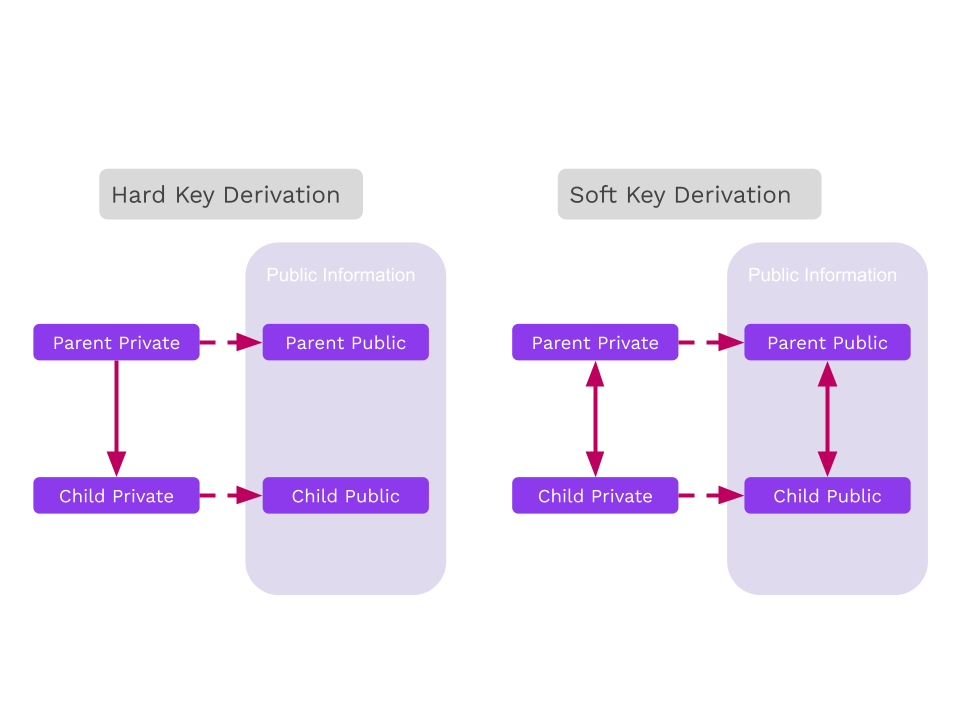Addresses and Keys
How to use the slides - Full screen (new tab)
Addresses and Keys
Outline
- Binary Formats
- Seed Creation
- Hierarchical Deterministic Key Derivation
Binary Display Formats
When representing binary data, there are a few different display formats you should be familiar with.
Hex: 0-9, a-f
Base64: A-Z, a-z, 0-9, +, /
Base58: Base64 without 0/O, I/l, +, and /
Notes:
Be very clear that this is a display format that we use to transmit binary data through text. The same data can be encoded with any of these formats, it's just important to know which one you're using to decode. Data is not typically stored in these formats unless it has to be transmitted through text.
Binary Display Formats Example
Every hex character is 4 bits. Every base64 character is 6 bits. base58 characters are usually about 6 bits.
binary: 10011111 00001010 10011110 10011000 01001100 11010011 10110010 00000101
hex: 9 f 0 a 9 e 9 8 4 c d 3 b 2 0 5
base64: n w q e m E z T s g U=
base58: T b u H z e 3 c t k c
hex: 9f0a9e984cd3b205
base64: nwqemEzTsgU=
base58: TbuHze3ctkc
Notes:
It turns out that converting from hex/base64 to base58 can in theory take n^2 time!
Mnemonics and Seed Creation
Notes:
These are all different representation of a secret. Fundamentally doesn't really change anything.
Seeds are secrets
Recall, both symmetric and asymmetric cryptography require a secret.
Mnemonics
Many wallets use a dictionary of words and give people phrases,
often 12 or 24 words, as these are easier to back up/recover than byte arrays.
Notes:
High entropy needed. People are bad at being random. Some people create their own phrases... this is usually stupid.
Dictionaries
There are some standard dictionaries to define which words (and character sets) are included in the generation of a phrase. Substrate uses the dictionary from BIP39.
| No. | word |
|---|---|
| 1 | abandon |
| 2 | ability |
| 3 | able |
| 4 | about |
| 5 | above |
The first 5 words of the BIP39 English dictionary
Mnemonic to Secret Key
Of course, the secret key is a point on an elliptic curve, not a phrase.
BIP39 applies 2,048 rounds of the SHA-512 hash function
to the mnemonic to derive a 64 byte key.
Substrate uses the entropy byte array from the mnemonic.
Portability
Different key derivation functions affect the ability to use the same mnemonic in multiple wallets as different wallets may use different functions to derive the secret from the mnemonic.
Cryptography Types
Generally, you will encounter 3 different modern types of cryptography across most systems you use.
- Ed25519
- Sr25519
- ECDSA
We will go more in depth in future lectures!
Notes:
You may have learned RSA in school. It is outdated now, and requires huge keys.
What is an address?
An address is a representation of a public key, potentially with additional contextual information.
Notes:
Having an address for a symmetric cryptography doesn't actually make any sense, because there is no public information about a symmetric key.
Address Formats
Addresses often include a checksum so that a typo cannot change one valid address to another.
Valid address: 5GEkFD1WxzmfasT7yMUERDprkEueFEDrSojE3ajwxXvfYYaF
Invalid address: 5GEkFD1WxzmfasT7yMUERDprk3ueFEDrSojE3ajwxXvfYYaF
^
E changed to 3
Notes:
It hasn't been covered yet, but some addresses even go extra fancy and include an error correcting code in the address.
SS58 Address Format
SS58 is the format used in Substrate.
It is base58 encoded, and includes a checksum and some context information. Almost always, it is 2 bytes of context and 2 bytes of checksum.
base58Encode( context | public key | checksum )
Notes:
| here stands for concatenation.
For ECDSA, the public key is 33 bytes, so we use the hash of it in place of the public key.
There are a lot more variants here, but this is by far the most common one.
HDKD
Hierarchical Deterministic Key Derivation

Hard vs. Soft
Key derivation allows one to derive (virtually limitless)
child keys from one "parent".
Derivations can either be "hard" or "soft".
Hard vs. Soft

Hard Derivation
Hard derivation requires the secret key and derives new child secret keys.
Typical "operational security" usages should favor hard derivation over soft derivation because hard derivations avoid leaking the sibling keys, unless the original secret is compromised.
Always do hard paths first, then conclude in soft paths.
Hard Derivation in Wallets
Wallets can derive keys for use in different consensus systems while only needing to back up one secret plus a pattern for child derivation.

Hard Derivation in Wallets
Let's imagine we want to use this key on multiple networks, but we don't want the public keys to be connected to each other.

Subkey Demo
Hard Derivation
Notes:
Hard keys: Take a path (data like a name/index), concatenate with the original key, and hash it for a new key. They reveal nothing about keys above them, and only with the path between it and children could they be recovered.
Soft Derivation
Soft derivation allows one to create derived addresses from only the public key. Contrary to hard derivation, all keys are related.
Notes:
- With any key and the paths to children and. or parents, the public and private keys can be recovered.
- Soft derivations can break some niche advanced protocols, but our sr25519 crate avoids supporting protocols that conflict with soft derivations.
Soft Derivation
- Note that these generate new addresses, but use the same secret seed.
- We can also use the same paths, but only using the Account ID from
//polkadot. It generates the same addresses!
Soft Derivation in Wallets
Wallets can use soft derivation to link all payments controlled by a single private key, without the need to expose the private key for the address derivation.
Use case: A business wants to generate a new address for each payment, but should be able to automatically give customers an address without the secret key owner deriving a new child.
Notes:
On the use case, taking each payment at a different address could help make the association between payment and customer.
See: https://wiki.polkadot.network/docs/learn-accounts#soft-vs-hard-derivation
Subkey Demo
Soft Derivation
Notes:
See the Jupyter notebook and/or HackMD cheat sheet for this lesson.
Mention that these derivations create entirely new secret seeds.